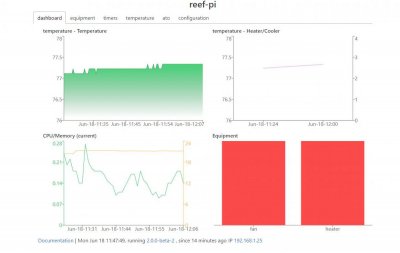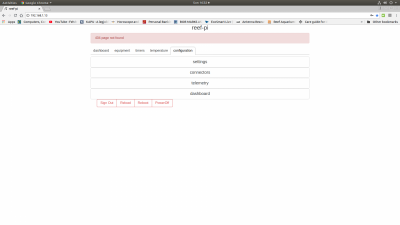I run my relay on a external power supply. The only thing from the relay connected to the pi are the GPIO Pins and the Ground... The pi uln and relays must share a common ground ...Hi again Q if i drive the 8 ch relay board from external 5v how to give vcc from raspberry to relay board.What Ranjib send me gpio pin out ther is vcc on #1 pin but that is Temp VCC
Navigation
Install the app
How to install the app on iOS
Follow along with the video below to see how to install our site as a web app on your home screen.
Note: This feature may not be available in some browsers.
More options
You are using an out of date browser. It may not display this or other websites correctly.
You should upgrade or use an alternative browser.
You should upgrade or use an alternative browser.
reef-pi :: An opensource reef tank controller based on Raspberry Pi.
- Thread starter Ranjib
- Start date
-
- Tags
- controller raspberry-pi
- Tagged users Ranjib
Thank you
Thank you i will try that.Try to drive with external 5vI run my relay on a external power supply. The only thing from the relay connected to the pi are the GPIO Pins and the Ground... The pi uln and relays must share a common ground ...
Thank you
Thank you i will try that.Try to drive with external 5v
Thank you really appreciate your help.Now that is easy.Just need to go buy a ULN 2803.tomorrow i can try.Thank you againpower on pin 10 of the uln is not used is not needed
you can test without the uln2803.. Some even run the without it.Thank you really appreciate your help.Now that is easy.Just need to go buy a ULN 2803.tomorrow i can try.Thank you again
- Joined
- Mar 22, 2017
- Messages
- 48
- Reaction score
- 30
Is it possible to have data stored longer in 2.0? I would like to have much longer graphs - maybe the graph could be customizable? Adafruit.io isn't working for me and besides it is limited unless you pay a monthly fee.
I can confirm this board works with Raspberry Pi. I send the analog output through an MCP3008 10-bit analog to digital converter chip which communicates to the Raspberry Pi through SPI. If anyone is interested I can share the setup, wiring diagram, and python code which handles calibration and readout. You can also find this board on eBay if you search for "arduino ph probe". Not sure if is a cheaper price or not. Be warned, you still need a decent ph probe, the cheap one mine came with was fine for developing with, but once I replaced it with a good probe I see the accuracy and response time is much better.Im afraid it wont. The circuit you linked requires and analog input pin, pi does not have any. You are right, the current reef-pi ph code is tied to AtlasScientific circuit (their i2c protocol to be specific), but we can revisit that, change it to support something else if theres a compelling reason. I did a fair amount of research before going with atlas scientific probes/circuit. My finding was getting a marine aquarium compatible probe that will be used for continuous monitoring is not cheap. Atlas was the only supplier with some reputation. I do agree its expensive :-( .
I am learning electronics, and once my chops are good enough, I'll certainly attempt to address this. From my discussion with @theatrus , it looks like we should be able to use a dedicated micro controller and to roll our own ph circuit (that does the analog voltage to ph conversion along with voltage isolation. But thats a distant future
In terms of working, its doing very well.. no hiccups. The only problem has been my tank pH is much lower than what is normal. My SPS are growing (i wont call them crazy growth), LPS ans zoas are thriving.. tank is almost grown out.. and the ph monitor shows stead ph trend of daily highs and peaks that range between 6.3-> 7.2 .. then I added kalkwasser (almost a month now) and itw hovers between 6.9 to 7.5 ... I have cross tested the readings with both API test kit as well as another test kit , and the results tally. I also re-checked the actual probe with calibration solution (4, 7 and 10) and cross checked with temperature compensation. At this point, the conculsion is my tank pH is low.. much lower than normal (in fact corals should melt in the lowest pH )... and thats simply not possible (according the Randy and few others who are more familiar with the subject). I have not lost my sleep over this, as my tank is stable and dont show much sign of stress and I have done pretty much evrerything I could easily do to validate the probe is calibrated and current readings are matching with titration based kits.
My next step will be to measure ph (with titration based kit and preferably something else other than API) at midnight / early morning when the ph records lowest.
From a controller build perspective I am confident. i.e. software and circuitry are all sound. The next step on this front is to incroporate it in the AIO build and see how the circuit works our while used in conjuction with all other things..but I do not expect a lot of surprise there. Its my tanks reading that I have to get to the bottom
As stated previously, I have also done some work with ph probes before I came upon this thread. One thing I noticed: my ds18b20 temp probe is leaking some stray voltage into my tank when it was fully submerged. This is just enough to be picked up by the ph probe and lower the ph readings. Once I take probe out of water ph readings rise. I am now going to give the ds18b20 a nice coating in silicone to make sure it is insulated. You might want to run a test with the temp probe in the water, and then take it out and see if it has any effect. This could explain the low readings in the tank, but perfect readings when in the calibration cups. Of course the ph could just be low in the tank too.
As stated previously, I have also done some work with ph probes before I came upon this thread. One thing I noticed: my ds18b20 temp probe is leaking some stray voltage into my tank when it was fully submerged. This is just enough to be picked up by the ph probe and lower the ph readings. Once I take probe out of water ph readings rise. I am now going to give the ds18b20 a nice coating in silicone to make sure it is insulated. You might want to run a test with the temp probe in the water, and then take it out and see if it has any effect. This could explain the low readings in the tank, but perfect readings when in the calibration cups. Of course the ph could just be low in the tank too.
No mater what you do, your pumps are going to leak voltage that affect a pH probe. You have to isolate the pH probe. Look into galvanic isolation or check out atlas scientific. They sell serial enabled chips that are isolated. If you don’t do this, then anytime there is other electrical equipment in the tank, your pH reading will be off. I tried to build three pH circuits for my tank before I discovered this.
I want users to be able to customize this. Currently reef-pi keeps week worth of data, but I certainly want to revisit that as part of 2.0 releaseIs it possible to have data stored longer in 2.0? I would like to have much longer graphs - maybe the graph could be customizable? Adafruit.io isn't working for me and besides it is limited unless you pay a monthly fee.
Got it. Does it make a difference if the tank have grounding probe or not ?No mater what you do, your pumps are going to leak voltage that affect a pH probe. You have to isolate the pH probe. Look into galvanic isolation or check out atlas scientific. They sell serial enabled chips that are isolated. If you don’t do this, then anytime there is other electrical equipment in the tank, your pH reading will be off. I tried to build three pH circuits for my tank before I discovered this.
Got it. Does it make a difference if the tank have grounding probe or not ?
Interesting question. I never tested that but I don’t think so. Even with a grounding probe, the AC sinusoidal voltages from the pump will still be in the water and hitting the tip of the probe. I still think this will create an issue of not isolated. I’m not 100% sure, but that is where my intuition is leading me.
Got it. I'll go ahead an order the inline voltage isolator circuit from atlas scientific, thats the one promises to provide galvanic isolation. I was under the assumption its for within pcb/circuit interference (i.e. when other probes are attached) not from the environment. Thanks for pointing this out. I'll also run a set of tests with and without temp sensor in the tank and update you all, while the voltage isolation circuit is on the wayInteresting question. I never tested that but I don’t think so. Even with a grounding probe, the AC sinusoidal voltages from the pump will still be in the water and hitting the tip of the probe. I still think this will create an issue of not isolated. I’m not 100% sure, but that is where my intuition is leading me.
Woot :-O)And the second part when everything looks beautiful

That little red bar is a bug in beta release.. Nothing wrong with your setup, i'll clean it up before the final 2.0 release
Thank you Ranjib i was not sure i did something again or just the beta testing. Everything is working perfect on the bread board now i should try the arrangement in a box and change for perma proto board.Thank you for your work.
Making progress. Mounting everything in an old PC case I had kicking around. Lots of power options in there.
What settings do you all find work well on the ATO
What settings do you all find work well on the ATO
- Joined
- Mar 22, 2017
- Messages
- 48
- Reaction score
- 30
I'm also having trouble with the lighting values going to Adafruit.Greetings everyone! I recently put together a tc reef-pi build and it was a lot fun. This was my first time doing anything with a Raspberry pi or linux and everything went along smoothly thanks to the build guides and everyone on this thread.
I'm having an issue with telemetry. On adafuit, only the default created system-load5 and system-mem-used feeds are getting data. How can I get the temperature feed to work?

Similar threads
New Posts
-
-
Hey guys new here!!coral question..slightly concerned
- Latest: AlkalinityTheif98
-
-



















